The Australian Treasury has released briefing slamming the federal government’s ‘migrants to the bush’ policy and has called for a comprehensive population policy aimed at maximising living standards:
There is a need for a population strategy that focuses migration on improving Australian living standards, while taking into account Australia’s capacity to absorb the associated rates of population growth, and humanitarian and family reunion obligations…
The Government’s commitment to a comprehensive population strategy that builds on community consultation has the potential to galvanise improvements in managing population growth.
…population growth can exacerbate existing policy concerns associated with the current lack of forward planning, under-investment in infrastructure and inadequate environmental settings. This is especially likely to be the case when the rate of growth exceeds what is planned for by different tiers of government.
Australia’s capacity to accommodate a growing, yet sustainable population, depends crucially on planning and investing for that population now. As the States make many of the pertinent policy trade-offs regarding population, careful consideration needs to be given to Commonwealth attempts to influence their decisions…
It is expected that much of the population growth will occur in cities, in line with Australian and worldwide experience over the last century. Over the next 20 years, around two-thirds of the increase in Australia’s population is projected to occur in capital cities. The choices of people and businesses to locate in cities is driven by the productivity growth of urban areas that generates economic opportunity and access to services. The ability of government to counteract these long-established forces through regional policy would appear limited…
Historical experience shows regional settlement policies are expensive and ineffective, and result in an inefficient allocation of resources. This will particularly be the case in a full employment economy where any short-term employment and economic gains of one locality will inevitably come at the expense of another.
Policies that directly ensure regional areas are adequately served by infrastructure, manage external costs generated by cities (such as congestion) or reduce the cost of moving from one region to another are likely to generate the most efficient and lasting outcomes…
A regular independent report (by Treasury or a body like the Productivity Commission) outlining 20-year aggregate, geographic and demographic population projections could inform the planning and investment of all three tiers of government.
Ensuring the IGR is linked to these independent projections and is perceived to be an independent assessment of the sustainability of government policies would aid credibility. A recommended change would be to release the IGR every three years as a Treasury rather than a Treasurer document.
So basically, the Australian Treasury does not support the Coalition’s ‘migrants to the bush’ policy, noting that it is “expensive and ineffective, and [would] result in an inefficient allocation of resources”.
Instead, the Treasury wants a “population strategy” aimed at maximising “Australian living standards” and based upon “community consultation”. It also wants a whole lot more honesty from Government around immigration, and has called for a “regular independent report… outlining 20-year aggregate, geographic and demographic population projections” that is free from the political interference experienced by the IGR.
The above briefing sounds substantially different to the Treasury’s recent immigration propaganda report, doesn’t it? So why the difference?
Well, the above briefing was provided in 2010 as part of Treasury’s Red Book advice to incoming Prime Minister Gillard in 2010. However, since that briefing was delivered, none of the recommendations have been put in place by subsequent federal governments.
Instead, Australia’s population has ballooned by a whopping 3 million people since 2010. And the political ecosystem surrounding population growth has become more fragmented and dysfunctional than ever, as has the concentration of immigration into our big cities, in spite of continued efforts to decentralise through various regional visa schemes. As a result, infrastructure and living standards in Sydney and Melbourne have become even more degraded, with residents in these cities also forced to live in smaller and more expensive housing.
Remember, too, that Scott Morrison slammed the ‘migrants to the bush’ policy in 2010-11 as “false hope” and “unrealistic”, while also calling for immigration to be “throttled back” because he was “not comfortable with the 36 million [population] projection” (since revised upwards to 38 million in the latest IGR!).
Instead of deploying various policy smokescreens and buzzwords – like ‘migrants to the bush’, ‘better planning’ and ‘just build more infrastructure’ – our politicians and policy makers needs to deal with the problem at its source and reduce immigration back to more manageable and sustainable historical levels:

They cannot possibly hope to ameliorate the many problems caused by excessive population growth while continuing to run an immigration program that is roughly triple the historical average.

